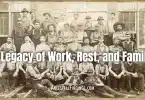A lovely spot for a fun-filled family vacation or day out together, Prickett’s Fort State Park comprises 188 acres of land in beautiful West Virginia, just north of Fairmont, where Prickett’s Creek and the Monongahela River converge. The central focal point of the park is the reconstructed fort, but there is so much more to the park than this, including a rich history.
Prickett’s Fort was built around 1774, with the purpose of defending the new British settlers from raids by local Native American tribes. At the time, most of the local tribes were hostile to the new settlers, as those settlers appropriated parts of their historic territory. This appropriation was accomplished with the Treaty of Fort Stanwix in 1768.
Things were quiet for a time on the new West Virginian frontier, but in 1774, Daniel Greathouse lead a group of settlers in a massacre of local Native Americans, in what was known as the Yellow Creek Massacre, and it was the beginning battle of what became Lord Dunmore’s War. All of the settlers in the area became at increased risk for Native American raiding after that, regardless of whether they had taken part in the massacre or the war or not.
The settlers built a number of protective forts at this time, where they could gather in large numbers, so as to be better able to protect themselves from the Natives. One of these forts was built on Jacob Prickett’s homestead. It was relatively simple in design, being merely a log barricade of one hundred feet that was built around Prickett’s house. However, it served its purpose, as the local Native Americans preferred to raid small groups of people working in the fields or woods, rather than these fortified and well-manned structures.
If a Native raid was suspected, neighbors gathered at the nearest fort….something they called “forting up.” Prickett’s fort was able to house up to eighty families (which comprised several hundred people) during these times. Sometimes, the gathered families stayed for days or even weeks at a time. However, Prickett’s fort was never the object of a Native American raid. Local militiamen from the area of Prickett’s fort were killed by Natives farther away from the fort at times, though.
Prickett’s Fort disappears from the historical records after 1780, when things seemed to settle down on the West Virginian frontier. The Sons of the American Revolution dedicated a monument to the settlers who built the fort in 1916. The site of the original fort was rescued from potential parking lot destruction from the Department of National Resources in 1973 when the Marion County Historical Society formed the Prickett’s Fort Memorial Foundation and said they were going to reconstruct the fort there.
The original fort was suspected to have been destroyed by the construction of a railroad bridge in 1905. The site of the original fort was also rendered unusable by this construction. So, the new Foundation decided to reconstruct the fort on a hill that overlooks the river. A number of old buildings from the area that were no longer usable or restorable were donated to the project, with their lumber being used to build the new fort. The fort itself was built using a description by a Stephen Morgan, who was a grandson of an early settler of the area.
Morgan’s account later proved to be an inaccurate one, resulting in the construction of a fort that was much more elaborate than the original one. However, it is assumed that most of the features of the reconstructed fort could have been found on any of the protective forts in the area at the time the original fort was constructed. The reconstructed fort is a building that is 110 feet square, with blockhouses of two stories at each corner, and fourteen smaller cabins lining the inside of the fortification walls. There is also a meeting house and a storehouse within the walls.
In addition to the fort reconstruction, the park includes a research library, a gift shop, and a gallery where one can view an orientation exhibit and introductory video. Third-person presentations are given at the fort on such topics as 1700’s blacksmithing, carpentry, and spinning wool into yarn. There is also the Job Prickett house on the property, which is an 1800’s era farmhouse built by Jacob Prickett’s grandson. This house has many original Prickett family furniture and tools in it, and it is listed on the National Register of Historic Places.
At the park, one can enjoy picnic areas, nature trails, a boat launch, and even a four hundred-seat outdoor amphitheater. The amphitheater is used by the Drama department at Fairmont State University to produce musicals and dramatic plays in the summers, to the delight of park visitors.
The park is a day-use park, with daily admittance required to enjoy the facilities. All historical re-enactments and special events at the park are managed by the Pricketts Fort Memorial Foundation, which has a long-term contract with the state to perform these tasks.
The gift shop, orientation area, and administrative offices are open each day from 10 am to 4 pm until Labor Day, when they are closed on Mondays and Tuesdays. After October 28, they are also closed on weekends, until the visiting season begins again in April.
The visiting season at the park begins on April 22 and goes until October 27 each year. The park is open Monday through Saturday from 10 am to 4 pm during the visiting season, and on Sundays from 12 pm to 4:30 pm. The park may be open at additional hours during the visiting season if special events are being held there.
Admission to the park is $8.00 for adults, $6.00 for seniors age 60 and above, $4.00 for children ages 6 to 12, and free for children age 5 and under. Members of the park are also admitted for free.






